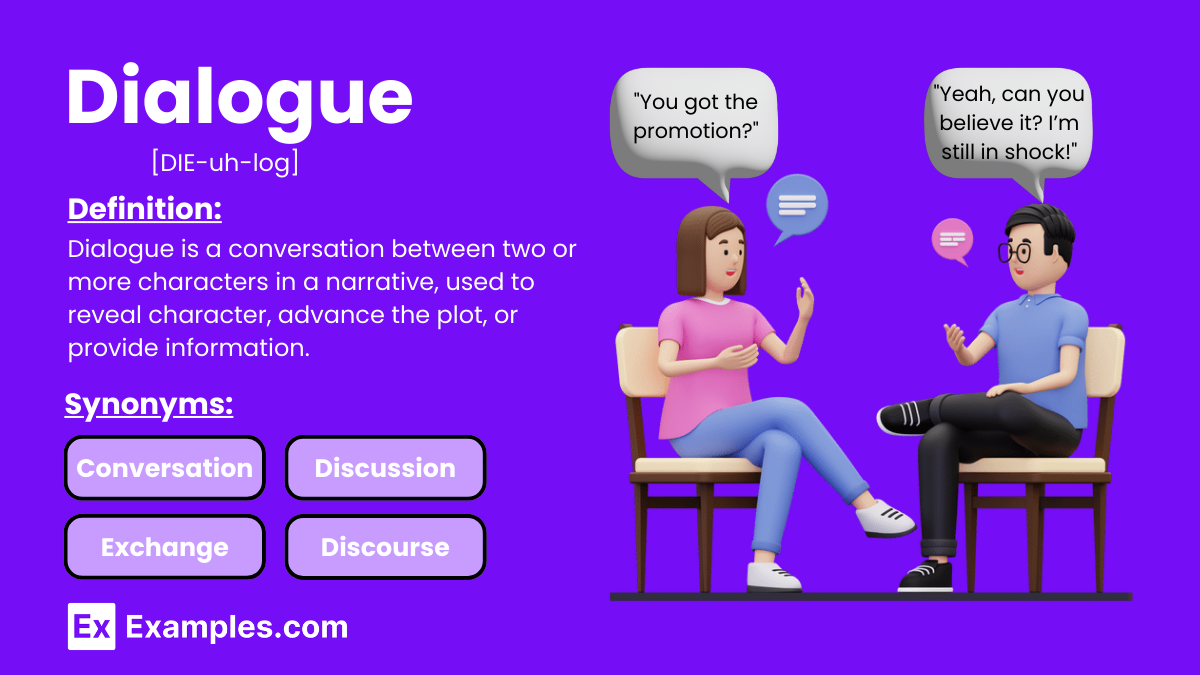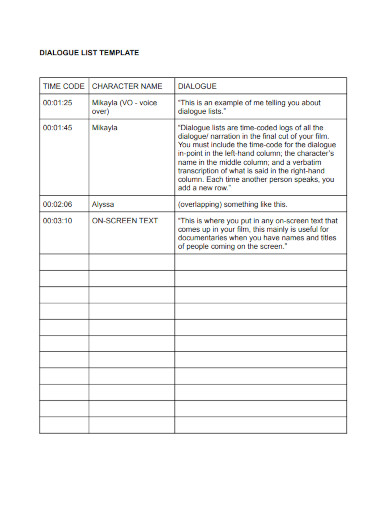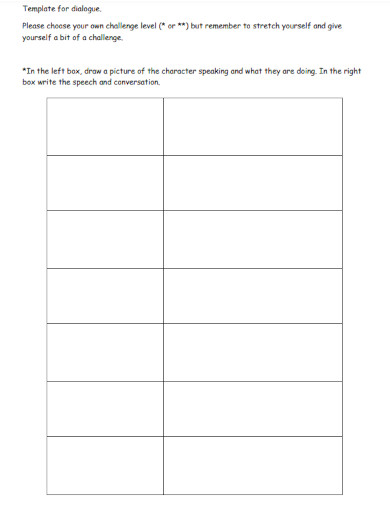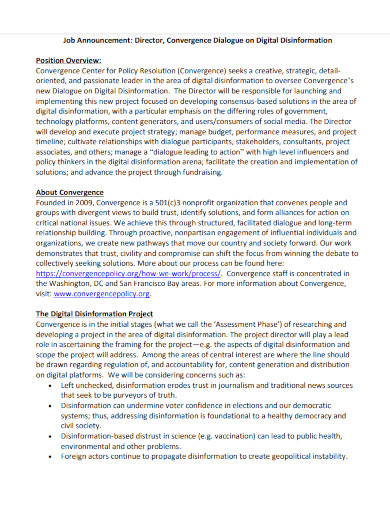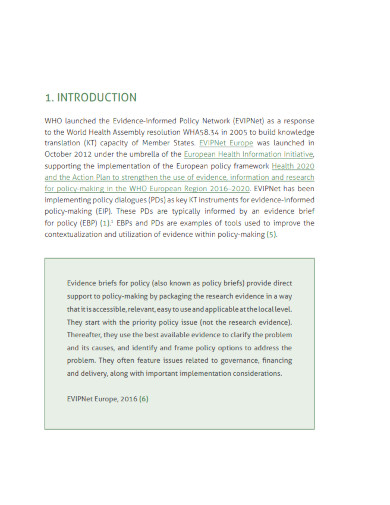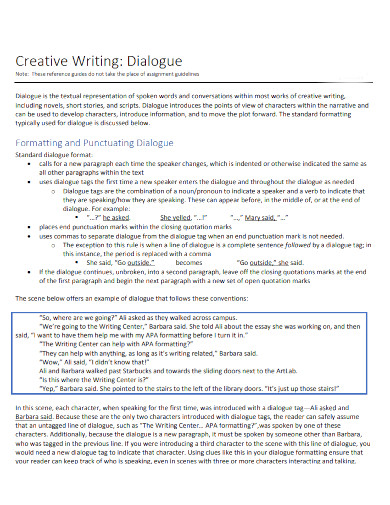Dialogue
A writer has many tools and techniques in their arsenal to obtain the attention and interest of the reader. One of these techniques is in the shape of a dialogue that occurs when two or more characters vocally interact with one another.
What Is a Dialogue?
Dialogue is an element in a story that deals with two or more characters interacting with one another in a single scene. If you want to do a deep dive into the framework of dialogue or need a template, an example you may refer to articles named Tripolis Dialogue, Dialogue Handbook, and Autonomous Dialogue for Interactive Story Telling on the links above.
Dialogue Examples in Writing
1. Expressing Surprise
- Character A: “You got the promotion?”
- Character B: “Yeah, can you believe it? I’m still in shock!”
2. Showing Conflict
- Character A: “Why didn’t you tell me about the meeting?”
- Character B: “I thought you already knew. Besides, you never listen to me anyway.”
3. Creating Tension
- Character A: “Are you hiding something from me?”
- Character B: “Why would I hide anything? You’re just being paranoid.”
4. Revealing Emotions
- Character A: “I can’t do this anymore.”
- Character B: “What do you mean? Are you leaving?”
5. Demonstrating Friendship
- Character A: “Thanks for being there for me.”
- Character B: “Always. That’s what friends are for.”
6. Introducing Humor
- Character A: “Did you hear about the mathematician who’s afraid of negative numbers?”
- Character B: “No, what about him?”
- Character A: “He’ll stop at nothing to avoid them!”
7. Exchanging Information
- Character A: “Do you know where the library is?”
- Character B: “Yeah, it’s just around the corner, next to the coffee shop.”
8. Building Romantic Tension
- Character A: “You look beautiful tonight.”
- Character B: “Thanks. You’re not so bad yourself.”
9. Offering Reassurance
- Character A: “What if I fail?”
- Character B: “You won’t. And even if you do, I’ll be here to help you get back up.”
10. Making Decisions
- Character A: “Should we take the job in New York?”
- Character B: “I think we should. It’s a big move, but it’s a great opportunity.”
Dialogue Examples in Literature
1. “Pride and Prejudice” by Jane Austen
- Elizabeth: “From the very beginning— from the first moment, I may almost say— of my acquaintance with you, your manners impressing me with the fullest belief of your arrogance, your conceit, and your selfish disdain of the feelings of others, were such as to form the groundwork of disapprobation on which succeeding events have built so immovable a dislike; and I had not known you a month before I felt that you were the last man in the world whom I could ever be prevailed on to marry.”
- Mr. Darcy: “You have said quite enough, madam. I perfectly comprehend your feelings, and have now only to be ashamed of what my own have been.”
2. “To Kill a Mockingbird” by Harper Lee
- Atticus: “Remember it’s a sin to kill a mockingbird.”
- Scout: “Why?”
- Atticus: “Mockingbirds don’t do one thing but make music for us to enjoy. They don’t eat up people’s gardens, don’t nest in corncribs, they don’t do one thing but sing their hearts out for us. That’s why it’s a sin to kill a mockingbird.”
3. “The Great Gatsby” by F. Scott Fitzgerald
- Nick: “You can’t repeat the past.”
- Gatsby: “Can’t repeat the past? Why of course you can!”
4. “Harry Potter and the Sorcerer’s Stone” by J.K. Rowling
- Hagrid: “You’re a wizard, Harry.”
- Harry: “I’m a what?”
5. “The Catcher in the Rye” by J.D. Salinger
- Holden: “People always clap for the wrong things.”
6. “1984” by George Orwell
- Winston: “Does Big Brother exist?”
- O’Brien: “Of course he exists. The Party exists. Big Brother is the embodiment of the Party.”
7. “The Hobbit” by J.R.R. Tolkien
- Bilbo: “Good morning!”
- Gandalf: “What do you mean? Do you wish me a good morning, or mean that it is a good morning whether I want it or not; or that you feel good this morning; or that it is a morning to be good on?”
8. “Moby-Dick” by Herman Melville
- Captain Ahab: “From hell’s heart I stab at thee; for hate’s sake I spit my last breath at thee. Ye damned whale.”
9. “The Adventures of Huckleberry Finn” by Mark Twain
- Huck: “All right, then, I’ll go to hell.”
10. “Frankenstein” by Mary Shelley
- The Creature: “I am malicious because I am miserable. Am I not shunned and hated by all mankind?”
Dialogue Examples in a Story
1. Expressing Surprise
Context: Sarah unexpectedly meets her old friend Mike at a coffee shop.
- Sarah: “Mike? Is that you?”
- Mike: “Sarah! Wow, I can’t believe it’s really you. How long has it been?”
2. Showing Conflict
Context: Emma confronts her brother Jack about using her car without permission.
- Emma: “Why did you take my car without asking?”
- Jack: “I needed it for an emergency. You weren’t using it anyway.”
- Emma: “That’s not the point, Jack. You should have asked.”
3. Creating Tension
Context: Detective Jones interrogates a suspect, Tom, about his alibi.
- Detective Jones: “Where were you last night at 10 PM?”
- Tom: “I already told you, I was at home.”
- Detective Jones: “Funny, because we have a witness who says otherwise.”
4. Revealing Emotions
Context: Lily tells her best friend, Rachel, about her recent breakup.
- Lily: “I can’t do this anymore, Rachel. It’s over between us.”
- Rachel: “Oh, Lily, I’m so sorry. Do you want to talk about it?”
5. Demonstrating Friendship
Context: Ben helps his friend Mark move into a new apartment.
- Mark: “Thanks for helping me with all these boxes.”
- Ben: “No problem. What are friends for?”
6. Introducing Humor
Context: Jake and Sam joke around while waiting for the bus.
- Jake: “Why did the scarecrow win an award?”
- Sam: “I don’t know, why?”
- Jake: “Because he was outstanding in his field!”
7. Exchanging Information
Context: Alex asks Jamie for directions to the library.
- Alex: “Do you know where the library is?”
- Jamie: “Yeah, it’s just around the corner, next to the coffee shop.”
8. Building Romantic Tension
Context: During a dinner date, Anna and John discuss their future.
- John: “You look beautiful tonight.”
- Anna: “Thanks. You’re not so bad yourself.”
9. Offering Reassurance
Context: Karen comforts her friend Lisa, who is worried about a job interview.
- Lisa: “What if I mess up the interview?”
- Karen: “You won’t. And even if you do, I’ll be here to help you get back on your feet.”
10. Making Decisions
Context: Tom and Linda discuss whether to take a job offer in another city.
- Tom: “Should we take the job in New York?”
- Linda: “I think we should. It’s a big move, but it’s a great opportunity.”
Dialogue Examples in Novels
1. “The Road” by Cormac McCarthy
Context: A father and son navigate a post-apocalyptic world.
- The Boy: “What would you do if I died?”
- The Man: “If you died I would want to die too.”
- The Boy: “So you could be with me?”
- The Man: “Yes. So I could be with you.”
2. “The Book Thief” by Markus Zusak
Context: Liesel Meminger talks with her foster father, Hans Hubermann.
- Liesel: “How about a kiss, Saumensch?”
- Hans: “What did you call me?”
- Liesel: “You heard me.”
3. “Gone Girl” by Gillian Flynn
Context: Nick and Amy Dunne confront each other about their troubled marriage.
- Nick: “What are you thinking? How are you feeling? What have we done to each other? What will we do?”
- Amy: “We’re so cute. I want to punch us in the face.”
4. “Life of Pi” by Yann Martel
Context: Pi Patel describes his ordeal at sea with a Bengal tiger.
- Pi: “I will not die. I refuse it. I will make it through this nightmare. I will beat the odds, as great as they are. I have survived so far, miraculously. Now I will turn miracle into routine. The amazing will be seen every day.”
5. “The Night Circus” by Erin Morgenstern
Context: Celia and Marco discuss the nature of their magical competition.
- Celia: “I’m tired of trying to hold things together that cannot be held.”
- Marco: “I’m not sure I understand.”
- Celia: “I’m tired of magic.”
6. “The Shadow of the Wind” by Carlos Ruiz Zafón
Context: Daniel Sempere and his father talk about books and memories.
- Daniel: “A secret’s worth depends on the people from whom it must be kept.”
- Father: “And one must always protect secrets, even from those who know them.”
7. “Neverwhere” by Neil Gaiman
Context: Richard Mayhew encounters Door in the underground world of London Below.
- Richard: “You don’t look like you’d be any good in a fight.”
- Door: “I look like an angel, but I slice like a demon.”
8. “Beloved” by Toni Morrison
Context: Sethe talks to her daughter Denver about their past.
- Sethe: “I did it. I got us all out. Without Beloved and without you, I would have died in that shack.”
- Denver: “You got us out, Mama. You got us safe.”
9. “The Handmaid’s Tale” by Margaret Atwood
Context: Offred reflects on her situation in Gilead.
- Offred: “We were the people who were not in the papers. We lived in the blank white spaces at the edges of print. It gave us more freedom. We lived in the gaps between the stories.”
10. “The Kite Runner” by Khaled Hosseini
Context: Amir speaks with Rahim Khan about his guilt and redemption.
- Rahim Khan: “There is a way to be good again.”
- Amir: “How?”
Dialogue Examples in Movies
1. The Godfather (1972)
- Vito Corleone: “I’m gonna make him an offer he can’t refuse.”
2. Forrest Gump (1994)
- Forrest Gump: “My mama always said, ‘Life was like a box of chocolates. You never know what you’re gonna get.'”
3. Star Wars: Episode V – The Empire Strikes Back (1980)
- Darth Vader: “I am your father.”
4. The Dark Knight (2008)
- Joker: “Why so serious?”
5. Casablanca (1942)
- Rick Blaine: “Here’s looking at you, kid.”
6. The Wizard of Oz (1939)
- Dorothy: “Toto, I’ve a feeling we’re not in Kansas anymore.”
7. Titanic (1997)
- Jack Dawson: “I’m the king of the world!”
8. A Few Good Men (1992)
- Col. Jessep: “You can’t handle the truth!”
9. Gone with the Wind (1939)
- Rhett Butler: “Frankly, my dear, I don’t give a damn.”
10. The Lord of the Rings: The Fellowship of the Ring (2001)
- Gandalf: “A wizard is never late, Frodo Baggins. Nor is he early; he arrives precisely when he means to.”
More Samples & Templates of Dialogue in PDF
1. Dialogue List Template
2. Template for Dialogue
ns_row class=”row”]
[/ns_row]3. Dialogue Handbook Template
4. Director, Convergence Dialogue on Digital Disinformation
5. Policy Dialogue Preparation and Facilitation Checklist
6. Creative Writing Dialogue
Dialogue Techniques
Effective dialogue can bring characters to life and drive the narrative forward. Here are several techniques to enhance your dialogue writing:
1. Realistic Speech Patterns
- Mimic the natural rhythm and flow of real conversations.
- Example:
- Realistic: “I dunno… Maybe we could just stay in tonight?”
- Unrealistic: “I do not know. Perhaps we could remain indoors this evening.”
2. Use of Subtext
Convey underlying meanings without explicitly stating them.
- Example:
- Subtext: “Nice job on the presentation.” (When the tone indicates sarcasm)
- Explicit: “Your presentation was terrible.”
3. Character-Specific Voice
Give each character a unique way of speaking that reflects their background, personality, and mood.
- Example:
- Character A: “Hey, what’s up?”
- Character B: “Greetings. How do you do?”
4. Avoiding On-the-Nose Dialogue
Avoid making characters say exactly what they feel or think.
- Example:
- On-the-Nose: “I am angry with you for lying to me.”
- Subtle: “I can’t believe anything you say anymore.”
5. Interruptions and Overlapping Speech
Use interruptions and overlapping dialogue to mimic real conversations.
- Example:
- Character A: “I really think we should—”
- Character B: “—No, I don’t want to hear it.”
6. Use of Silence
Utilize pauses and silences to convey tension or emotion.
- Example:
- “Did you…?” He hesitated, searching her face. “Did you really mean that?”
7. Indirect Dialogue
Summarize dialogue rather than quoting it directly.
- Example:
- Instead of: “I can’t believe you did that,” she said.
- Use: She expressed her disbelief at his actions.
8. Incorporating Action with Dialogue
Combine dialogue with actions to add depth and context.
- Example:
- “I’m not scared,” he said, though his hands trembled.
9. Using Dialects and Accents Sparingly
Use dialects and accents to add authenticity but avoid overdoing it to prevent readability issues.
- Example:
- Light Use: “Y’all coming to the party?”
- Overdone: “Y’all gon’ be comin’ to da party?”
10. Internal Dialogue
Use internal thoughts to reveal a character’s true feelings.
- Example:
- He said, “I’m fine,” but inside, he was screaming for help.
Rules for Formatting Dialogue
Formatting dialogue correctly is essential for clarity and engagement in writing. Here are the essential rules for formatting dialogue:
1. Use Quotation Marks
- Enclose all spoken words within quotation marks.
- Example:
- Correct: “I can’t wait for the weekend,” she said.
- Incorrect: I can’t wait for the weekend, she said.
2. Start a New Paragraph for Each Speaker
- Begin a new paragraph each time the speaker changes.
- Example:
- Correct:
- “What are your plans for the weekend?” John asked.
- “I’m thinking of going hiking,” Mary replied.
- Incorrect: “What are your plans for the weekend?” John asked. “I’m thinking of going hiking,” Mary replied.
- Correct:
3. Punctuation Inside Quotation Marks
- Place periods, commas, question marks, and exclamation points inside the quotation marks.
- Example:
- Correct: “Are you coming to the party?” he asked.
- Incorrect: “Are you coming to the party”? he asked.
4. Use Dialogue Tags Appropriately
- Use tags like “he said” or “she asked” to identify the speaker, placing them after the dialogue or at a natural pause.
- Example:
- Correct: “I don’t know,” she whispered.
- Incorrect: “I don’t know” she whispered.
5. Interrupting Dialogue with Tags
- If a dialogue tag interrupts a sentence, use commas to set it off.
- Example:
- Correct: “If you want to go,” he said, “we can leave now.”
- Incorrect: “If you want to go” he said “we can leave now.”
6. Action Tags
- Use action tags to describe what the speaker is doing, which can replace dialogue tags.
- Example:
- Correct: “I can’t believe it!” She slammed the door.
- Incorrect: “I can’t believe it!” she slammed the door.
7. Multiple Sentences
- If a speaker says multiple sentences, use quotation marks only at the beginning and end of the entire speech.
- Example:
- Correct: “I’m not sure what to do. Maybe we should ask for help.”
- Incorrect: “I’m not sure what to do.” “Maybe we should ask for help.”
Elements of Effective Dialogue
Effective dialogue is crucial for creating compelling and realistic narratives. Here are the key elements that contribute to writing impactful dialogue:
1. Realism
Make dialogue sound like real conversation.
- Example: “I can’t believe we’re finally here!” vs. “I cannot believe that we have arrived at this location.”
2. Character Voice
Each character should have a unique way of speaking.
- Example: A teenager might say, “That’s cool,” while an elderly person might say, “That’s quite impressive.”
3. Subtext
Use dialogue to imply meanings rather than stating them directly.
- Example: “Oh, you’re home early,” implies something unsaid, like suspicion or surprise.
4. Conflict and Tension
Introduce conflict or tension to make dialogue interesting.
- Example: “I can’t believe you did that!” vs. “I wish you had asked me first.”
5. Purpose
Dialogue should advance the plot or develop characters.
- Example: “We need to find the key before midnight,” pushes the plot forward.
Synonyms & Antonyms of Dialogue
| Synonyms | Antonyms |
|---|---|
| Conversation | Silence |
| Discussion | Monologue |
| Exchange | Soliloquy |
| Chat | Quiet |
| Talk | Isolation |
| Communication | Monotony |
| Discourse | Noncommunication |
| Banter | Stillness |
| Dialogue | Solitude |
| Confabulation | Reticence |
Dialogue vs. Dialog
| Aspect | Dialogue | Dialog |
|---|---|---|
| Spelling | Common in British English | Common in American English |
| Usage | Preferred in formal writing | Used interchangeably in informal contexts |
| Context | Literary, conversational | Computer interfaces, tech-related contexts |
| Example Sentence | “The dialogue in the novel is captivating.” | “The software update improved the dialog boxes.” |
| Etymology | Derived from Greek “dialogos” | Simplified spelling adaptation |
How To Write an Engaging Dialogue
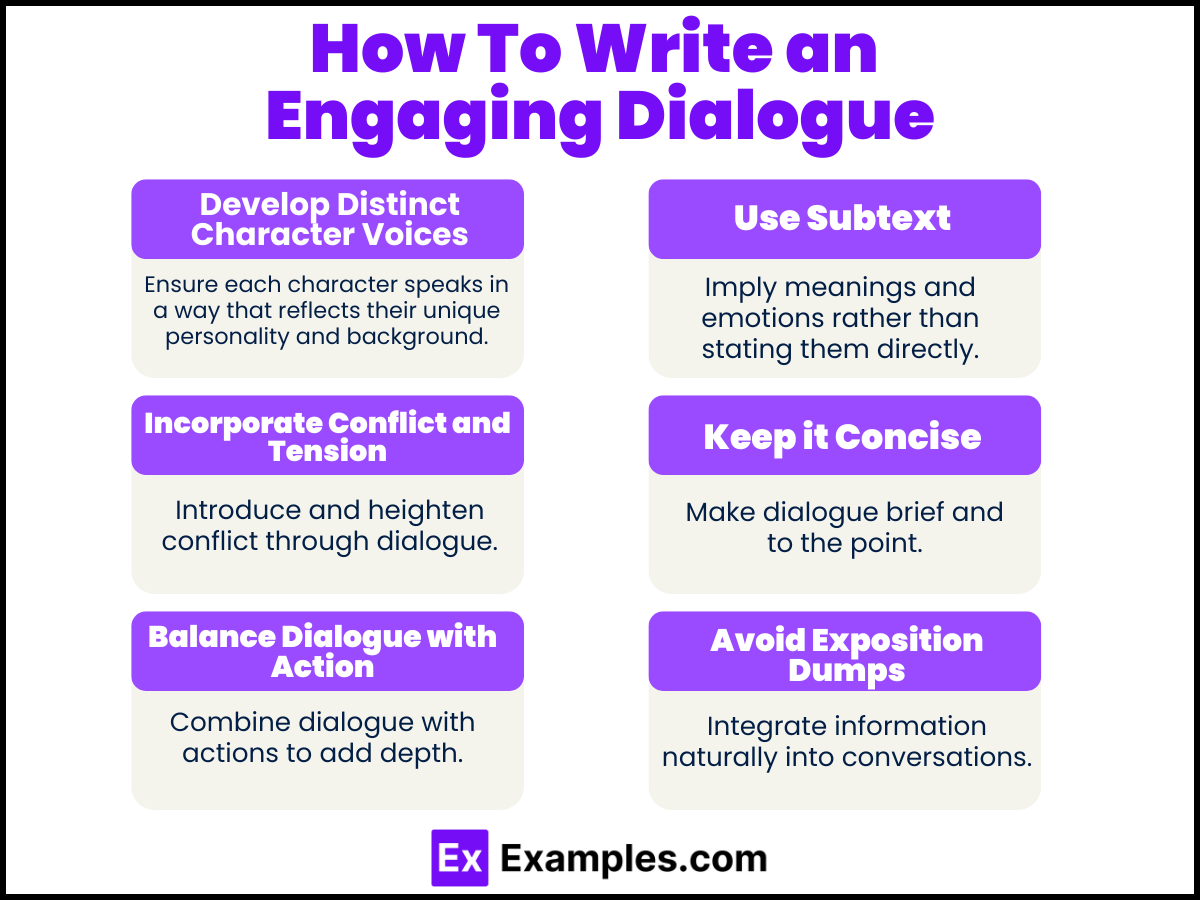
Writing engaging dialogue is crucial for creating dynamic and relatable characters. Here are some key tips and techniques:
1. Develop Distinct Character Voices
- Ensure each character speaks in a way that reflects their unique personality and background.
- Example: “That’s lit!” vs. “That’s quite impressive.”
2. Use Subtext
- Imply meanings and emotions rather than stating them directly.
- Example: “Must be nice to get everything you want,” instead of “I’m jealous.”
3. Incorporate Conflict and Tension
- Introduce and heighten conflict through dialogue.
- Example: “I told you not to touch my things!” vs. “I was just trying to help.”
4. Keep it Concise
- Make dialogue brief and to the point.
- Example: “Let’s go to the store,” instead of, “I think that maybe we should consider going to the store if you’re not too busy.”
5. Balance Dialogue with Action
- Combine dialogue with actions to add depth.
- Example: “I’m leaving,” he said, grabbing his coat.
6. Avoid Exposition Dumps
- Integrate information naturally into conversations.
- Example: “Remember when we first met? It feels like forever ago,” instead of, “As you know, we’ve been friends for ten years and during that time…”
How do you create distinct character voices?
Give each character unique speech patterns, vocabulary, and expressions reflecting their background, personality, and emotions.
How can dialogue advance the plot?
Use dialogue to reveal key information, create conflict, and drive the story forward through character interactions and decisions.
What makes dialogue realistic?
Mimic natural speech patterns, use contractions, interruptions, and ensure characters speak in ways appropriate to their personalities and backgrounds.
How do you balance dialogue with action?
Combine dialogue with descriptive actions to enhance context and depth, showing characters’ emotions and reactions.
What is the role of subtext in dialogue?
Subtext implies underlying meanings and emotions, allowing characters to communicate indirectly, adding depth and complexity.
How do you avoid exposition dumps in dialogue?
Integrate information naturally into conversations, revealing details gradually through interactions rather than lengthy monologues.
What are common dialogue mistakes?
Avoid unrealistic speech, overuse of names, exposition dumps, and excessive dialogue tags.
How can interruptions improve dialogue?
Natural interruptions and overlapping speech mimic real conversations, adding realism and dynamic flow.
How do you show character emotions through dialogue?
Use tone, word choice, and actions accompanying speech to convey emotions without explicitly stating them.
What techniques make dialogue engaging?
Use conflict, tension, humor, and unique character voices to create dynamic and captivating conversations.



